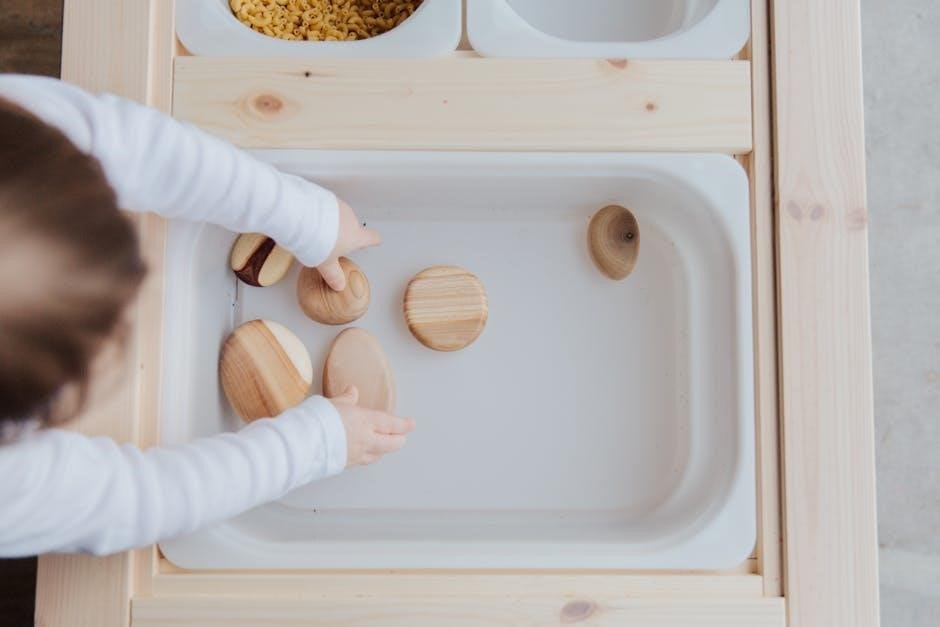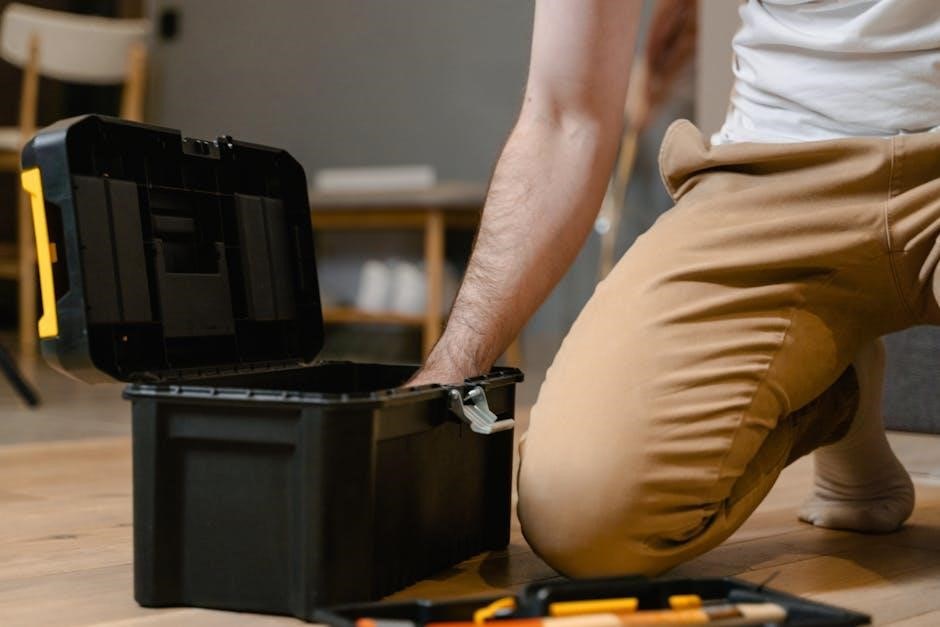Quick Start Guide
1.1 Unboxing and Initial Setup
Unbox your Sonos Play:1, ensuring all accessories like the power cable and Ethernet cable are included. Place the speaker in your desired location.
1.2 Connecting to Power
Plug the power cable into the speaker and a nearby outlet. Ensure the speaker is properly powered on.
1.3 Downloading the Sonos App
Download and install the Sonos app from the App Store (iOS) or Google Play (Android) to control your speaker.
1.4 Initial Configuration via the App
Open the Sonos app, select “Set up new system,” and follow the in-app instructions to connect your Play:1 to your network.
Carefully unpack your Sonos Play:1 speaker, ensuring all components are included: the speaker, power cable, Ethernet cable, and documentation. Place the speaker in your desired location, considering optimal audio performance. The compact design allows easy placement on shelves or tables. Ensure the speaker is positioned upright and stable. Avoid blocking the grille or placing it near water. Take a moment to familiarize yourself with the controls and LED indicators on the top panel. This initial setup prepares your speaker for connection and configuration.
Connect the Sonos Play:1 to a power source using the provided cable. Plug one end into the speaker’s power port and the other into a nearby electrical outlet. Ensure the connection is secure. The speaker will automatically power on once connected. If using an Ethernet connection for a wired setup, attach the Ethernet cable to the speaker and your router. This step ensures stable power and network connectivity. Refer to the manual for specific cable requirements and safety precautions to avoid damage to the speaker or electrical issues.
Download the Sonos app from the App Store (for iOS) or Google Play Store (for Android). Open the app, select “Set up new system,” and follow the prompts to create or sign in to your Sonos account. The app will guide you through connecting your Play:1 to your Wi-Fi network and completing the initial setup. Ensure your device is connected to the same network for a seamless installation process. This step is crucial for controlling and customizing your speaker’s settings.
Open the Sonos app, select “Set up new system,” and follow the guided steps. Create a Sonos account or sign in if you already have one. The app will detect your Play:1 and prompt you to name the room where it’s located. Ensure your device is connected to the same Wi-Fi network as your speaker. Complete the setup by confirming your network password. Once connected, your Play:1 is ready to stream music and integrate with other Sonos products seamlessly.

Setting Up Your Sonos Play:1
Launch the Sonos app, select ‘Add a Speaker,’ and follow the in-app instructions to connect your Play:1 to your network. Create a new system or add to an existing one.
2.1 Adding to an Existing Sonos System
Open the Sonos app, navigate to Settings, and select “Add Speaker or Component.” Choose your Play:1 from the list of available devices. Follow the in-app instructions to complete the setup. The speaker will automatically connect to your existing Sonos system, ensuring seamless integration. This process typically takes less than 10 minutes and enhances your home audio experience with expanded coverage and synchronized sound.
2.2 Setting Up a New Sonos System
Open the Sonos app and select “Set up new system.” Create or sign in to your Sonos account, then follow the in-app instructions to add your Play:1. The app will guide you through connecting the speaker to your Wi-Fi network. Once connected, your new Sonos system is ready to use. This process is straightforward and quick, ensuring you can start enjoying high-quality sound immediately. Refer to the setup guide for detailed steps if needed.
2.3 Network Configuration Options
The Sonos Play:1 supports both wireless and wired network configurations. For wireless setup, connect to your home Wi-Fi network through the Sonos app. You can also use an Ethernet cable for a stable wired connection. The app guides you through network selection or manual IP configuration. Additionally, the speaker can be added to an existing Sonos system or set up as a standalone device. Ensure your router supports 2.4 GHz or 5 GHz bands for optimal performance. This flexibility allows you to customize your network setup based on your home audio needs.
2.4 Using Ethernet for a Wired Connection
For a stable connection, connect your Sonos Play:1 to your router using an Ethernet cable. Locate the Ethernet port on the speaker’s back, plug in one end of the cable, and connect the other end to your router. Open the Sonos app, navigate to settings, and select the network configuration option. Choose the wired connection, and the app will guide you through the setup. Ensure your router supports 2.4 GHz or 5 GHz bands. This setup offers reliable audio streaming and minimizes Wi-Fi interference, enhancing your listening experience with consistent playback.

Design and Build Quality
The Sonos Play:1 features a compact, stylish design with durable materials, available in black and white, ensuring a seamless fit in any home decor.
3.1 Physical Dimensions and Weight
The Sonos Play:1 measures 4.7 inches in height, 3.3 inches in width, and 3.1 inches in depth, making it compact for placement in small spaces. It weighs 3.9 pounds, ensuring stability without being overly heavy. The speaker’s lightweight design allows easy relocation while maintaining a sturdy presence in any room setup.
3.2 Available Colors and Aesthetic Appeal
The Sonos Play:1 is available in two sleek colors: black and white, offering a modern and timeless aesthetic. Its compact design blends seamlessly into any home decor, making it a versatile choice for various interiors. The speaker features a smooth, matte finish that enhances its understated elegance. Its minimalist design ensures it complements both traditional and contemporary settings without drawing unnecessary attention. The color options allow users to choose a shade that matches their room’s style, ensuring the speaker becomes a subtle yet stylish addition to their space.
3.3 Materials and Durability
The Sonos Play:1 is crafted with high-quality materials, ensuring durability and longevity; Its metal grille provides protection while maintaining acoustic performance. The speaker’s cabinet is made from a robust polymer, designed to withstand normal wear and tear. The overall build feels solid and premium, reflecting Sonos’ attention to detail. The smooth, matte finish resists fingerprints and scratches, maintaining its appearance over time. This combination of materials and construction ensures the Play:1 remains a reliable and long-lasting addition to any home audio setup.
3.4 Button Controls and LED Indicators
The Sonos Play:1 features intuitive button controls located on the top of the speaker. The buttons include volume up, volume down, and a play/pause button, allowing for easy control of your music playback. An LED indicator located above the buttons provides visual feedback for actions like power status, connectivity, and volume adjustments. The LED also flashes during setup or when the speaker is updating. This simple yet functional design ensures seamless interaction with your speaker without needing to open the app. The buttons are responsive and durable, designed for long-term use.

Sound Quality and Performance
The Sonos Play:1 delivers balanced frequency response with deep bass and clear highs, offering rich, immersive sound despite its compact size.
4.1 Frequency Response and Sound Profile
The Sonos Play:1 boasts a frequency response of 50 Hz to 20 kHz, delivering deep bass and clear highs for a balanced sound profile. Its compact design produces rich, immersive audio with accurate mid-range reproduction. The speaker excels in small to medium-sized rooms, offering consistent sound quality across various genres. Compared to larger Sonos models, the Play:1 maintains impressive performance, ensuring detailed audio without distortion. Trueplay tuning further enhances its sound profile by adapting to room acoustics, making it a versatile choice for music lovers seeking high-fidelity sound in a compact form.
4.2 Comparisons with Other Sonos Speakers
The Sonos Play:1 is a compact yet powerful speaker, offering balanced sound at an affordable price. Compared to the Sonos Play:3 and Play:5, it lacks deeper bass but excels in smaller spaces. Its size and portability make it ideal for secondary rooms or as rear surrounds in a home theater setup. While it doesn’t match the Play:5’s dynamic range, its clarity and mid-range accuracy are impressive for its size. The Play:1 also supports stereo pairing, enhancing its soundstage and making it a versatile option for various listening scenarios.
4.3 Maximizing Sound Quality in Different Rooms
To optimize the Sonos Play:1’s sound quality, position it at least 1-2 feet away from walls to prevent bass buildup. Use the Trueplay feature in the Sonos app to calibrate the speaker to your room’s acoustics, ensuring balanced sound. For smaller rooms, place the speaker at ear level and avoid corners to minimize echo. In larger spaces, consider pairing two Play:1s in stereo mode for a wider soundstage. Adjusting EQ settings via the app can further tailor the sound to your room’s environment, enhancing clarity and depth.
4.4 Stereo Pairing with Another Play:1
For enhanced sound quality, pair two Sonos Play:1 speakers in stereo mode. Open the Sonos app, go to Settings, and select “Speaker Pairing.” Choose the option to create a stereo pair, and follow the in-app instructions. This setup creates a dedicated left and right channel, delivering a wider soundstage and immersive audio experience. Ensure both speakers are connected to the same network and are updated to the latest firmware for optimal performance. Pairing is ideal for home theaters or music enthusiasts seeking balanced, room-filling sound.

Customizing Your Sonos Play:1
Customize your Sonos Play:1 by adjusting EQ settings, enabling voice controls, and using Trueplay for room calibration to optimize sound quality for your space.
5.1 Adjusting EQ Settings via the App
Navigate to the Sonos app, select your Play:1, and access the settings menu. Tap on “EQ Settings” to adjust bass, treble, and other frequencies to your preference. Use the sliders to fine-tune the sound profile for optimal listening experience. Save your settings to apply the changes. This feature allows customization of the speaker’s audio output to suit different genres of music or room environments. Adjustments are applied in real-time, enabling immediate feedback on sound quality.
5.2 Setting Up Voice Controls with Smart Speakers
To enable voice control, open the Sonos app and navigate to Settings. Select “Voice Services” and choose your preferred smart speaker platform, such as Amazon Alexa or Google Assistant. Follow the in-app instructions to link your accounts. Once connected, you can use voice commands to play music, adjust volume, or switch tracks. Ensure your smart speaker is properly configured and connected to the same network as your Sonos Play:1 for seamless integration. This feature enhances convenience and hands-free control of your speaker.
5.3 Creating a Stereo Pair for Enhanced Sound
To create a stereo pair, open the Sonos app and select your Play:1 speaker. Navigate to Settings, then “Speaker Settings,” and choose “Create Stereo Pair.” Select another Play:1 speaker from the list to pair. Follow the in-app prompts to complete the setup. This configuration separates the left and right audio channels, enhancing sound quality and immersion. Ideal for home theaters or music lovers, stereo pairing ensures balanced audio distribution for a more engaging listening experience.
5.4 Using Trueplay for Room Tuning
Trueplay optimizes your Sonos Play:1’s sound based on your room’s acoustics. Open the Sonos app, go to Settings, and select “Trueplay Tuning.” Follow the prompts to start the tuning process. Walk around the room with your mobile device to capture sound reflections. The speaker will emit test tones, and the app will analyze the audio; Once complete, your Play:1 will automatically adjust its sound profile for a more immersive and balanced listening experience tailored to your space.

App Control and Features
The Sonos app allows seamless control of your Play:1, enabling music streaming, playlist management, and speaker synchronization. Adjust settings and customize your listening experience effortlessly.
6.1 Navigating the Sonos App Interface
The Sonos app features an intuitive interface designed for easy navigation. The sidebar provides quick access to music services, playlists, and settings. The Now Playing screen displays track details and playback controls. Use the tabs to switch between browsing music, managing playlists, and adjusting speaker settings. The app also allows you to group speakers, adjust EQ settings, and access diagnostic tools. Customization options, such as setting up voice controls or stereo pairing, are seamlessly integrated into the interface for a tailored listening experience.
6.2 Adding Music Services and Streaming Platforms
Open the Sonos app and navigate to the Settings menu. Select “Music Services” to explore available streaming platforms. Choose your preferred service, such as Spotify, Apple Music, or Amazon Music, and sign in with your account credentials. Once connected, you can browse your music library, playlists, and radio stations directly through the app. This integration allows seamless access to your favorite tracks, ensuring a personalized listening experience. The app also supports multiple services, enabling you to switch between platforms effortlessly.
6.3 Creating and Managing Playlists
To create a playlist, open the Sonos app and go to the “Music” tab. Select “Library” to access your music collection. Choose songs or albums to add to a new playlist by clicking “Add to Playlist.” Name your playlist and save it for future access. To manage playlists, visit the “Library” section, where you can edit, rename, or delete existing playlists. Saved playlists appear in the “My Sonos” section for quick playback. This feature allows you to organize your music seamlessly and enjoy personalized listening sessions.
6.4 Synchronizing Multiple Speakers
To synchronize multiple Sonos speakers, open the Sonos app and select the desired rooms or speakers from the “Rooms” tab. Ensure all speakers are connected to the same network. In the app, go to “Settings,” then “Advanced Settings,” and enable “Synchronize Audio” if needed. This ensures all speakers play the same music in perfect sync. For multi-room setups, group speakers under “Create Group” in the app. This feature is ideal for whole-home audio or parties, providing a seamless listening experience across all synchronized speakers.

Home Theater Integration
Easily integrate your Sonos Play:1 into a home theater setup by using it as rear surrounds or pairing it with a Sonos soundbar for immersive sound.
7.1 Using Play:1 as Rear Surround Speakers
To enhance your home theater experience, use Sonos Play:1 as rear surround speakers. Open the Sonos app, go to Settings, and select “Add Surround Speakers.” Follow the in-app guide to pair your Play:1 with a Sonos soundbar like Arc or Beam. Place the speakers behind your listening area at ear height for optimal surround sound. This setup creates an immersive audio experience, perfect for movies and TV shows. Ensure proper placement and calibration through the app for the best results.
7.2 Pairing with a Sonos Soundbar
To pair your Sonos Play:1 with a Sonos soundbar, open the Sonos app and navigate to Settings. Select “Add Surround Speakers” and follow the in-app instructions. Ensure both devices are powered on and connected to the same network. The app will guide you through pairing the Play:1 with your soundbar, enhancing your home theater experience with synchronized audio. This setup allows for a seamless integration, creating a cohesive sound system for movies, music, and more.
7.3 Setting Up a Home Theater System
To set up a home theater system with your Sonos Play:1, start by opening the Sonos app and selecting “Home Theater” under the Settings menu. Choose your Sonos soundbar as the central component and follow the in-app instructions to pair the Play:1 as rear surround speakers. Ensure all devices are connected to the same network and properly powered on. Place the Play:1 speakers to the sides or rear of your room for an immersive audio experience. Once configured, test the setup by playing a movie or music to ensure synchronized sound across all speakers.
7.4 Ensuring Proper Speaker Placement
For optimal audio performance, place your Sonos Play:1 speakers at ear level and angled toward the listening area. Position rear surround speakers slightly above ear level, ensuring they are equidistant from each other and the room’s center. Keep the speakers at least 6-8 feet apart to avoid phase cancellation. Avoid placing them directly against walls or in corners, as this can cause echo or bass distortion. Use stands or mounts to achieve the ideal height and placement for a balanced home theater experience.

Troubleshooting Common Issues
- Check for connectivity issues by restarting your router and speaker.
- Resolve sound quality problems by ensuring proper placement and updating firmware.
- Restart the Sonos app if it fails to detect the speaker.
- Perform a factory reset if issues persist.
8.1 Diagnosing Connectivity Problems
Start by ensuring your Sonos Play:1 is properly connected to your network. Check if the speaker appears in the Sonos app. If not, restart your router and speaker.
Verify your Wi-Fi signal strength and ensure no physical obstructions are blocking the connection. Try moving the speaker closer to the router.
If issues persist, check for network congestion by switching to a less crowded Wi-Fi channel. Alternatively, use an Ethernet cable for a stable wired connection.
Resetting the speaker to factory settings can also resolve persistent connectivity issues.
8.2 Resolving Sound Quality Concerns
Ensure your Sonos Play:1 is placed in an optimal location, away from walls and obstructions, to maximize sound clarity. Check for firmware updates in the Sonos app, as outdated software can affect performance. If sound is distorted, adjust the EQ settings in the app to balance bass, treble, and midrange. Restart both the speaker and your router to refresh the connection. For persistent issues, perform a factory reset and reconfigure the speaker through the app. This often resolves unexpected sound quality problems.
8;3 Fixing App Connectivity Issues
Restart your router and Sonos Play:1 to refresh the connection. Ensure both devices are on the same Wi-Fi network. Close and reopen the Sonos app, or reinstall it if issues persist. Check for app updates in the App Store or Google Play. If problems continue, reset the speaker by pressing and holding the Play/Pause and Volume Down buttons simultaneously for 10 seconds. This restores default settings and often resolves connectivity problems. Reconfigure the speaker through the app to reestablish a stable connection.
8.4 Performing a Factory Reset
To factory reset your Sonos Play:1, press and hold the Play/Pause and Volume Down buttons simultaneously for 10 seconds. Release when the LED flashes green. This restores the speaker to its original settings. Note that all custom settings and configurations will be lost. After resetting, open the Sonos app to set up the speaker again. Ensure your device is connected to the same Wi-Fi network during reconfiguration. This process is useful for resolving persistent issues or preparing the speaker for transfer to a new owner.

Maintenance and Care
Regularly clean the grille with a soft cloth and update firmware via the Sonos app. Manage power consumption by turning off when not in use. Store properly in a cool, dry place when not in use for extended periods. Avoid exposure to extreme temperatures or moisture to maintain optimal performance and longevity of your Sonos Play:1 speaker.
9.1 Cleaning the Speaker Grille
To maintain your Sonos Play:1’s appearance, gently clean the speaker grille using a soft, dry cloth. For stubborn stains, lightly dampen the cloth with water, but avoid harsh chemicals or excessive moisture. Do not submerge or spray liquids directly on the grille, as this could damage the internal components. Regular cleaning prevents dust buildup and ensures optimal sound quality. For tougher stains, use a mild soap solution, but rinse thoroughly and allow the grille to dry completely before reinstalling it. This simple maintenance ensures your speaker looks and performs its best.
9.2 Updating Firmware Regularly
Regular firmware updates ensure your Sonos Play:1 operates with the latest features and improvements. To update, open the Sonos app, go to Settings > System > System Update. Check for available updates and follow the prompts to install. Firmware updates are typically automatic but can also be done manually. Ensure your speaker is connected to the internet during the update process. Updates improve performance, add new features, and enhance compatibility. Keep your system up-to-date for the best experience.
9.3 Managing Power Consumption
Managing power consumption on your Sonos Play:1 is straightforward. The speaker features an automatic standby mode, which activates after a period of inactivity to reduce energy use. To customize this, go to the Sonos app, select Settings > System > Energy Saver, and adjust the standby timer. Additionally, unplugging the speaker when not in use or using a smart power strip can further minimize power draw. These features help optimize energy efficiency while maintaining performance and convenience for users.
9.4 Storing the Speaker Properly
When storing your Sonos Play:1, place it in a cool, dry environment away from direct sunlight. Avoid extreme temperatures and humidity to prevent damage. Before storage, gently clean the speaker grille with a soft cloth. Use the original packaging or a protective cover to safeguard against dust and scratches. Ensure the speaker is unplugged and stored upright to maintain its internal components. Proper storage will help preserve the speaker’s performance and longevity.

Advanced Features
Explore enhanced features like voice control, Trueplay tuning, and stereo pairing. Utilize SonosNet for reliable connectivity and integrate with smart home systems for seamless control.
10.1 Using SonosNet for Reliable Wireless Performance
SonosNet is a dedicated wireless network created by Sonos to ensure reliable connectivity between speakers. It minimizes interference and dropouts, providing a stable connection for your Play:1. During setup, SonosNet is automatically configured when you connect your speaker to your router using Ethernet. This creates a separate, optimized network for your Sonos system, enhancing performance and reducing latency. For best results, ensure your Play:1 is placed in an area with minimal obstructions and avoid overlapping networks. Use the Sonos app to diagnose and optimize your network setup for peak performance.
10.2 Integrating with Smart Home Systems
The Sonos Play:1 can seamlessly integrate with popular smart home systems like Amazon Alexa and Google Assistant. Open the Sonos app, navigate to Settings, and select “Voice Services” to link your smart speaker. This allows voice control for playback, volume, and track selection. Additionally, the Play:1 can be incorporated into scenes and routines within your smart home setup, enabling synchronized actions with other devices. Ensure your smart home system is compatible and properly configured for optimal integration.
10.3 Setting Up Voice Commands
To set up voice commands for your Sonos Play:1, open the Sonos app and navigate to Settings > Voice Services. Choose your preferred voice assistant, such as Amazon Alexa or Google Assistant, and follow the prompts to link your account. Once connected, discover devices to ensure your Play:1 is recognized. Use voice commands like “Play music in the living room” to control playback. For volume control or skipping tracks, try “Turn up the volume” or “Next song.” Optionally, create routines in your smart home system for enhanced automation.
10.4 Accessing Diagnostic Tools
To access diagnostic tools for your Sonos Play:1, open the Sonos app and go to Settings > System > Diagnostic Tools. Here, you can run tests to identify connectivity or performance issues. Check the network connection status and speaker connectivity under “System Health.” Use “Network Matrix” to evaluate wireless performance between speakers. For advanced troubleshooting, visit the Sonos website and log into your account to access detailed diagnostic reports. These tools help resolve issues like dropouts or syncing problems, ensuring optimal performance.
